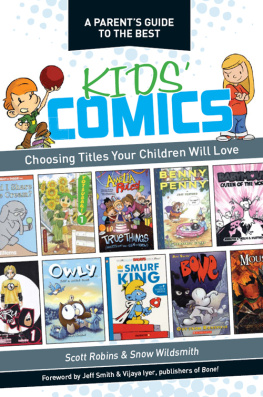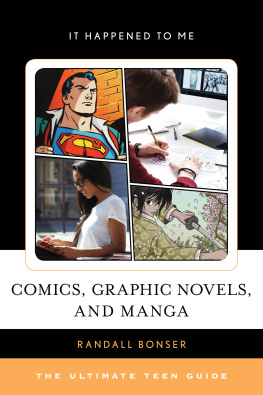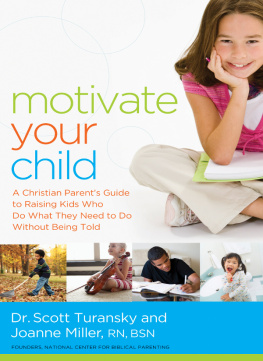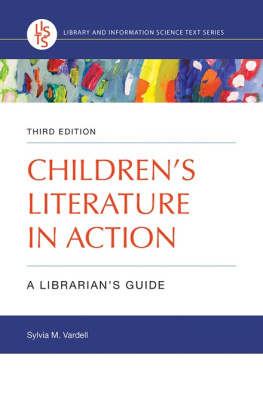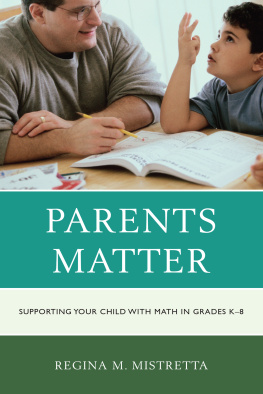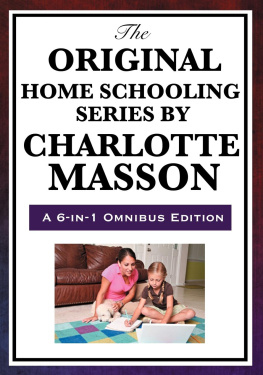FOREWORD

Jeff Smith and his wife, Vijaya Iyer, operate Cartoon Books and its website, www.boneville.com, where readers will learn more about their variety of projects, including the award-winning Bone.
By Jeff Smith and Vijaya Iyer
Comics and graphic novels are just a part of reading in a different medium, like reading a picture book or a text story or anything like that. A comic book is still just a book.
Comic books provide a wonderful form of reading that is perfect for kids though, of course, comics arent just for kids. Theyre a different kind of reading, separate from prose but not less than prose. And they work for kids really well, because it requires an extra amount of imagination to take in the pictures: Its a great way for kids to read. You turn the pages; you read left to right, top to bottom just like any other picture book or prose book.
We both grew up on comics. Vijaya cut her teeth on Peanuts, basically learning how to read with those compilations of comic strips. She wasnt a big comic-book reader, but comics definitely composed part of her learning how to read with the help of the pictures.
Like Vijaya, Jeff learned to read through Peanuts by looking at what Snoopy was doing on the top of his doghouse or what kind of lines were making up Charlie Browns mouth to show that his stomach hurt. And about the time he was 9, he got into the Pogo newspaper strip by Walt Kelly, which he still reads today and which works on many levels. The strip works on the funny-animal, slapstick level, which he enjoyed as a kid with Kellys drawings, but it also works on an adult level with topics covering everything from politics to the newspaper and workaday life. (Jeff didnt see the Pogo comic books until much, much later.)
Albert the alligator once said in the Pogo comic-book stories that he read pictures good. You really do have to read a picture; even a panel in a comic book that doesnt have any word balloons in it still has to be read by the reader. The kid still has to see that picture, process the action or the emotion of the facial expressions, and overlay a passage of time on top of that. As the readers eye goes over a course of a series of panels, each panel has information, whether worded or not: the passage of time, the movement of expression. Its a powerful, but a distinct, form of reading.
We dont think that process changes as the reader grows older. Jeff is still basically a 9-year-old in a 52-year-old body, and hes reading comics in exactly the same way as he was reading them decades ago. He can still go back and read Peanuts and he might have more life experience to bring to the party but Peanuts creator Charles Schulz knew what he was doing. He knew how to write a comic, and the reading experience is identical for child and adult alike.
Yet the experience of understanding is growing, as the reader brings different experiences and methodology to the process. You read things on a different level and differently, as you age. Of course, thats true for prose books, too. When you read The Lord of the Rings or The Odyssey when youre a teenager, and then you read them again when youre in college or in middle age, you will also bring different life experiences and baggage and get different outcomes. Theres no difference that way between prose and comics no difference from the way you process books as a child and then as an adult.
A Parents Guide to the Best Kids Comics makes an excellent way to begin to explore childrens comics, thanks to the descriptions, the selections, and the parental cautions. And, once youve begun to explore the field, the next step is to let your children go to the library and explore whatever areas they gravitate to. Its very helpful to have guidelines, but really its ultimately up to the child to pick what interests him or her.
Finally, we need to note that, when we were kids, the ones who read comics were the smart ones. They were the eggheads.
Ironically, one of the questions were most asked about involves the fact that comics seem to work for reluctant readers. Were fine with that. Were glad and we suppose we understand it, because theres fun, the characters have humor, and theres a lot of appeal to the form and the drawings. But we both resist the idea that comics are some kind of a gateway, a dumbed-down book for reluctant readers.
Comics are such a good way to read that even reluctant readers like them!
January 4, 2012
Columbus, Ohio
ACKNOWLEDGEMENTS
SCOTT AND SNOW WOULD LIKE TO THANK all of the wonderful writers, artists, publishers, and librarians who create, release, and support childrens comics. It is thanks to them that there are so many fantastic graphic novels for children to enjoy. We greatly appreciate all of the publishers who helped us get copies of books, gave us permission to use images, and offered us information, often at the very last moment. Thank you to Maggie and Brent for giving us such a great idea for a book and for working with us to bring it to life. Thank you especially to librarians Robin Brenner, Martha Cornog, Emily Leachman, Eva Volin, and Carlisle Webber, as well as Andrew Woodrow-Butcher from Little Island Comics and Leyla Aker from Viz Media, for their suggestions, encouragement, friendship, and support during this process. All our love to our partners Michael Lamore and Barry Gray for their moral support and patience. Scott and Snow would also like to each thank each other. Writing a book is challenging, but writing one with a dear friend is a challenge to savor.
Additionally, the authors and editors would like to thank the following for their help with this project:
Jason Wells, Abrams Books
Mary Ann Zissimos, Abrams Books
Jay Hosler, Active Synapse
Mel Caylo, Archaia Entertainment
Rik Offenberger, Archie Comics
Alex Segura, Archie Comics
Bessie McNamara, Blue Apple Books
Rob Shaefer, Blue Apple Books
Alexis E. Fajardo, Bowler Hat Comics
Jenny Choy, Candlewick Press
David Hyde, DC
Bridget E. Palmer, Disney
Gina Gagliano, First Second Books
Mimi Ross, Henry Holt
Jennifer Holm, creator
Kate Greene, Houghton Mifflin Harcourt
Marjorie Naughton, Houghton Mifflin Harcourt
Sarah Delaine, Image
Jamie Parreno, Image
Eva Svec, Kids Can Press
Elizabeth Dingmann, Lerner Books
Victoria Stapleton, Little, Brown
Andrew Woodrow-Butcher, Little Island Comics
Chad Solomon, Little Spirit Bear Productions
Arune Singh, Marvel
James Viscardi, Marvel
Ccile Camberlin, Moulinsart
Cory Casoni, Oni Press
Dayle Sutherland, Orca Books
Michael Petranek, Papercutz
Katie Fee, Penguin
Sara Sheiner, Penguin
Mary Sullivan, Penguin
Kelly Coyle-Crivelli, Random House
Sherri Feldman, Random House
Kate Gartner, Random House
Cathy Goldsmith, Random House
Isabel Warren-Lynch, Random House

